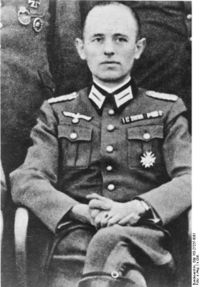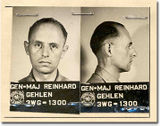Reinhard Gehlen
| Reinhard Gehlen | |
|---|---|
| 3 April 1902 – 8 June 1979 (aged 77) | |
 Colonel Reinhard Gehlen, c. 1943 |
|
| Place of birth | Erfurt, Germany |
| Place of death | Starnberg, Germany |
| Allegiance | |
| Service/branch | Wehrmacht Heer |
| Rank | Generalmajor |
| Battles/wars | World War II |
| Awards |
Deutsches Kreuz in silver during WWII Knight of Malta. |
Reinhard Gehlen (3 April 1902 – 8 June 1979) was a General in the German Army during World War II, who served as chief of intelligence-gathering on the Eastern Front. After WWII, he was recruited by the United States military to set up a spy ring directed against the Soviet Union (known as the Gehlen Organization), and eventually became head of the West German intelligence apparatus. He served as the first President of the Federal Intelligence Service until 1968. Gehlen is considered one of the most legendary Cold War spymasters.
Contents |
Early life and military service
Reinhard Gehlen was born into a Roman Catholic family in Erfurt, the son of a bookstore owner. He joined the Reichswehr in 1920 and entered the German Staff College graduating in 1935. He was promoted to captain and was attached to the Army General Staff.[1]
Under the Nazi government of Adolf Hitler, he was on the 1935/36 General Staff. In 1939, Gehlen was promoted to Major.[1] For the 1939 German attack of Poland he was a staff officer of an infantry division.[1] In 1940, Gehlen became the liaison officer to Army Commander-in-Chief Field Marshal Walther von Brauchitsch. He was then transferred to the staff of Army Chief of Staff General Franz Halder.
In July 1941, Gehlen was promoted to the rank of Lieutenant Colonel, deployed to the Eastern Front and assigned as senior intelligence officer to the German General Staff, section Fremde Heere Ost, FHO or Foreign Armies East.[2]
In the watershed year of 1942, according to Gehlen's memoir,[3] he was approached by Colonel Henning von Tresckow, Colonel Claus von Stauffenberg and General Adolf Heusinger to participate in an assassination attempt on German dictator Adolf Hitler. His role was to be minor. When the plot culminated in the failed bomb plot of 20 July 1944, Gehlen's role was covered up and he escaped Hitler's brutal retaliation against the conspirators. Throughout his years at FHO, Gehlen allowed determined anti-Nazis to hold conspiratorial discussions inside his section and he was present at Berchtesgaden in the final days before 20 July when details of the assassination attempt were discussed.[4]
In the spring of 1942 Reinhard Gehlen took over FHO from Colonel Eberhard Kinzel.[5] Even before the disaster of Stalingrad, Gehlen realized that FHO must be fundamentally reorganized and he methodically started the task to find the right personnel. He only allowed junior officers to remain who had recently joined FHO. Gehlen would scour army personnel files searching for linguists, geographers, anthropologists, lawyers; he accepted anyone who seemed suitable to him and likely would raise the intellectual level of FHO. A stream of fresh and energetic officers and experts flowed in.[6] It was this cadre that would build the comprehensive data file on the Red Army and then produce the assessments and "defeatist reports" that eventually, when reaching Hitler with their discouraging accuracy, would get Gehlen dismissed in April 1945. In December 1944, however, he received a last promotion, to the rank of Major General.[7] His organization had gathered immense knowledge on the Soviet Union and the battlefield tactics of the Red Army. When the Iron Curtain dropped in 1946, the Western Allies had virtually no source of intelligence for beyond that line. Gehlen’s information was to make him very valuable.[1]
Knowing all along that no final victory was on the cards for the regime he served, he began preparations to survive the fall of the Third Reich. Gehlen ordered the microfilming of the holdings of Fremde Heere Ost and had them placed in watertight drums. The drums were then buried in several places in the Austrian Alps.[8] He had fifty cases of archives buried at the Elendsalm in the mountains of Upper Bavaria,[9] to then wait for a buyer after the end of hostilities.
Post World War II

On May 22, 1945, Gehlen surrendered to the U.S. Army Counter Intelligence Corps (CIC) in Bavaria. He was brought to Camp King and interrogated by Captain John R. Boker near Oberursel. Because of his knowledge of and contacts inside the Soviet Union he was very valuable to the Americans. He offered them his intelligence archives and network in exchange for his liberty and the liberty of his colleagues imprisoned in American POW camps in Germany. Boker quietly removed Gehlen and his command from the official lists of American POWs and managed to transfer seven of Gehlen's senior officers to the camp. Gehlen's archives were picked up and brought to the camp secretly, even without the knowledge of the CIC. Towards the end of the summer Boker had the support of Brigadier General Edwin Sibert, the G2 (senior intelligence officer) of the Twelfth Army.[10] General Sibert contacted his superior, General Walter Bedell Smith, Eisenhower's chief of staff, who then worked with William Joseph Donovan and Allen Dulles, the former the head of the OSS, the latter then the OSS station chief in Bern, to make arrangements. On September 20, 1945, Gehlen and three close associates were flown to the United States to begin work for them. Gehlen also revealed a number of Office of Strategic Services (OSS) officers who were secret members of the U.S. Communist Party.
In July 1946 Gehlen was officially released from American captivity and flown back to Germany.[11] He began his intelligence work on 6 December 1946 by setting up an organization of former German intelligence officers at Oberursel near Frankfurt, then at Pullach near Munich,[1] called the “South German Industrial Development Organization” to mask his undercover operation and spy ring. Gehlen handpicked 350 former German intelligence agents to join him; that number eventually grew into 4,000 undercover agents. This group was soon to be given the nickname the "Gehlen Organization" or simply "the Org."
Gehlen Organization
Gehlen had all along been under the tutelage of US Army G-2 (intelligence), but he wished and succeeded in establishing an association with the Central Intelligence Agency, the CIA, established in 1947. The Gehlen Org employed hundreds of ex-Nazis.
The Org was for many years the only eyes and ears of the CIA on the ground in the Soviet Bloc nations during the Cold War. The CIA kept close tabs on the Gehlen group. Every German POW returning from Soviet captivity to West Germany between 1947 and 1955 was interviewed by Org agents. The Org had close contacts with east European émigré organizations. Unheralded tasks, such as observations of the operation of Soviet rail systems, airfields and ports were as important as was infiltration in the Baltic and the Ukraine. Operation Crossword infiltrated some 5,000 anti-communists of Eastern European and Russian ancestry. The Org "Operation Bohemia" was a major counter-espionage success.
The Gehlen Organization was severely compromised by East German communist moles within the organization itself, and communists and their sympathizers within the CIA and the British MI6, particularly Harold "Kim" Philby.
Once the Org emerged in minuscule steps from the shadows, Gehlen and his group were attacked relentlessly from both sides, the West and the East. The British in particular had a problem with Gehlen and segments of the English press made sure it became known.
BND
Ten years after the end of World War II, the Gehlen Organization was officially handed over to the government of the Federal Republic of Germany under Chancellor Konrad Adenauer.[1] On 1 April 1956 it formed the nucleus of the newly-created Bundesnachrichtendienst (BND or Federal Intelligence Service).[1] Gehlen held the top leadership post (President of the BND), presiding over spectacular successes as well as failures, until forced out in 1968. His downfall was as dramatic as his rise, triggered by the discovery of Heinz Felfe, an ex-SS lieutenant and Soviet agent in the Pullach headquarters complex;[12] by the break with Chancellor Adenauer already in 1963; and above all, by his increasing inattention to business and his delinquent leadership; altogether resulting in a decline in efficiency of the BND. He retired from government service in 1968 with the pension of a Ministrialdirektor (one of the most senior civil service grades),[13] plus, as alleged, a pension from the CIA. He died in 1979, aged 77.
Honors
Gehlen received the German Cross in silver during WWII and the Federal Cross of Merit with Shoulder Ribbon in 1968. He also was a Knight of Malta.
See also
- Gerhardt Boldt
Notes and references
- ↑ 1.0 1.1 1.2 1.3 1.4 1.5 1.6 Reinhard Gehlen - Biografie WHO'S WHO
- ↑ FHO was organized in 1938 (on the break-up of section "Foreign Armies") with the task to prepare situation maps of the Soviet Union, Poland, Scandinavia and the Balkans and to assemble information on potential adversaries
- ↑ Gehlen, Reinhard; trans. David Irving (1971). The Service — The Memoirs of General Reinhard Gehlen. New York: World Publishing. pp. 97–99.
- ↑ Höhne, Heinz & Zolling, Hermann, The General was a Spy, p. 38
- ↑ Höhne & Zolling, p. 10
- ↑ Höhne & Zolling, p. 13
- ↑ Höhne & Zolling, p. 44
- ↑ Christopher Simpson: BLOWBACK: The First Full Account of America's Recruitment of Nazis, and its disastrous Effect on our domestic foreign policy. Collier Books, New York 1988, ISBN 0-02-044995-X, pp. 41.
- ↑ Höhne & Zolling, p. 52
- ↑ Christopher Simpson: BLOWBACK: The First Full Account of America's Recruitment of Nazis, and its disastrous Effect on our domestic foreign policy. Collier Books, New York 1988, ISBN 0-02-044995-X, pp. 41–42.
- ↑ Höhne & Zolling, p. 63
- ↑ BND cryptanalysts deciphered KGB messages leading to Felfe
- ↑ Höhne & Zolling, p. 1
Bibliography and sources
- Cookridge, E.H. Gehlen: Spy of the Century. London: Hodder & Stoughton. 1971, and New York: Random House. 1972
- Hersh, Burton. The Old Boys — The American Elite and the Origins of the CIA. New York: Scibner’s. 1992
- Höhne, Heinz & Zolling, Hermann, The General was a Spy, The Truth about General Gehlen-20th Century Superspy. New York: Coward, McCann & Geoghegan, Inc. 1972.
- Jagd Gruppen 101. A Clinical insight into West German Death Squad 1945–196?
- Kross, Peter. "Intelligence" in Military Heritage, October 2004, p. 26–30
- Reese, Mary Ellen. General Reinhard Gehlen: The CIA Connection. Fairfax, Virginia: George Mason University. 1990
- United States National Archives, Washington, D.C. NARA Collection of Foreign Records Seized, Microfilm T-77, T-78
- Weiner, Tim. Legacy of Ashes: The History of the CIA, Trade Paperback, p. 10–190
External links
- Brief description of the Gehlen Organisation with details of many who worked for it
- "Disclosure" newsletter, Information promulgated by the U.S. National Archives & Records Administration
- Forging an Intelligence Partnership: CIA and the Origins of the BND, 1945-49 CIA declassified documents on the Gehlen Organization.
| Government offices | ||
|---|---|---|
| Preceded by None |
President of the Federal Intelligence Bureau 1956–1968 |
Succeeded by Gerhard Wessel |
|
|||||||